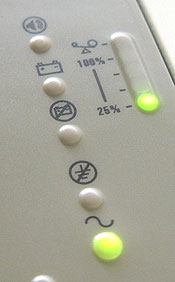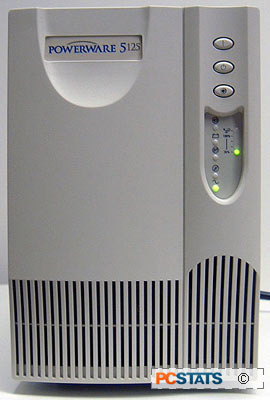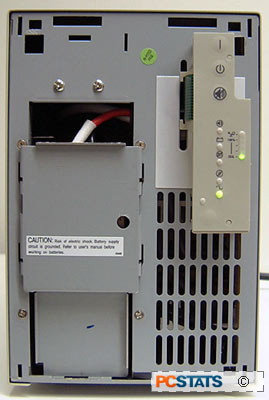Apparent Power is derived
from multiplying Voltage by Ampere's, which equals Volt-Amp's. So for example
if a 19" Samsung SyncMaster 900IFT monitor draws 120V, 1.2A, the
apparent power load is 120 (x) 1.2 = 144VA. While a good rule of thumb
for monitors, calculating apparent power by looking at the specs on the
side of the PCs power supply isn't very helpful for a whole bunch of reasons
which are beyond the scope of this review.
A 500W
Vantec Ion power supply may be rated for a maximum load
of 10A at 120V, but in real life it
probably won't come anywhere near that 1200VA requirement. To accurately
determine apparent power, P3 International sell a handy meter called the Kill-A-Watt which you can plug into the wall, and measure
loads of up to 1875VA.
If
this
all seems a little confusing, don't fret. As
an example, in this review we test the Powerware 5125 UPS with a
19" CRT monitor and pretty standard 2.0GHz Pentium4 computer whose combined power draw is
about 300VA. In other words, the 1000VA Powerware 5125 UPS is easily
adequate for a desktop PC or two and a large monitor. Although,
now might be a good time to mention that you should never ever run a laser
printer off a UPS, the heating elements inside simply draw too
much current.
Controls and Indicators on the Powerware 5125
 The control panel on
the front of the Powerware 5125 has the standard set of power on/off keys, along
with a few very useful icons which denote the status of several UPS power
settings.
The control panel on
the front of the Powerware 5125 has the standard set of power on/off keys, along
with a few very useful icons which denote the status of several UPS power
settings.
Looking
at the picture just to the left, we find battery
mode, service, ground fault, and AC power indicators, as well as a percent-load bar
graph. The LED illuminated
bar graph indicates at a glance, the percentage load on the UPS from all devices which
are plugged into it. If you've overloaded the Powerware 5125 UPS by plugging in too many
devices, the red overload LED will light up and an annoying alarm will sound. If
that happens it's best to unplug something to decrease the load. If the power goes out
and the UPS is overloaded, it will protect itself from damage by
quickly shutting down.
The AC status indicator is another indicator worth taking notice of because it illustrates, roughly, what the quality
of the AC power at any given moment is. For example, in the labs we
routinely see the mains supply rise up past 126V at the end of the day. When that happens,
the AC status LED will occasionally glow orange to indicate a slight over voltage. If
there is a voltage spike, the Powerware 5125 can go into a "bucking mode,"
where it drops the voltage supplied to connected devices down to normal levels.
On the other hand, if the utility power drops down to low, for whatever
reason, the Powerware 5125 will enter into a boost mode, where it compensates with battery power.
The UPS is pretty versatile. Voltages as high as 20% over normal, or 30%
under normal are automatically filtered and transformed for the devices plugged into one of the
Powerware 5125's six plug sockets.
Features on the Powerware
5125
Behind the plastic cover on the front of the
Powerware 5125 is where the battery is stored. The 26V DC sealed lead acid
batter is hot swapable, which means if it has failed (as indicated on the
control panel) it can be replaced with a new one without turning the UPS off.
Because there is only one battery in the unit, it cannot be replaced while the
UPS is running off battery power, obviously.


The battery is user
replaceable, so all anyone needs to do is have a spare battery on hand (from the
manufacturer), and consult the manual on the proper steps to follow.
